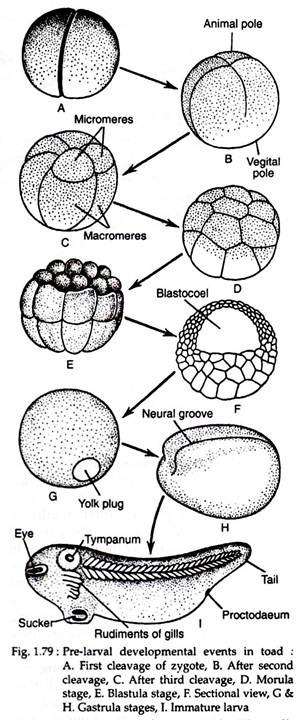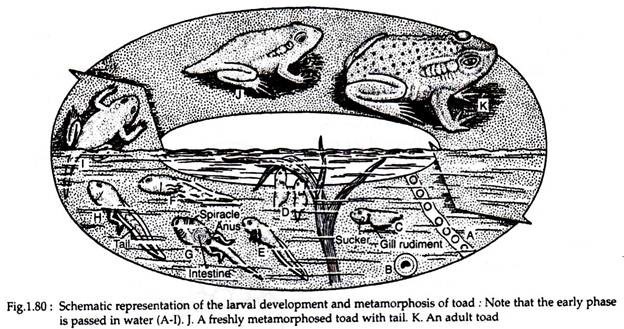The life-history of toad is very much complicated and discussed below:
Breeding Habits:
Breeding of toad takes place during monsoons. After a heavy shower of rainfall, the males call can be heard at the bank of ponds, ditches and near a stagnant rain water pool on land. On hearing the mating call, the female approaches. The male holds firmly the female by his fore and hind limbs.
When axillary amplexus begins, the female moves in the water for egg laying. During the breeding season sexual dimorphism is prevalent. Males possess black vocal sac and nuptial thumb-pad at each innermost finger of the hand. A single female may lay over a thousand eggs in any convenient patch of water.
ADVERTISEMENTS:
Structure of germ cells:
The eggs are spherical cells and mesolecithal type. Each egg has a blackish animal pole and a whitish vegetal pole. The animal pole is full of protoplasm and the vegetal pole is full of yolk. Such a type of egg is called telolecithal type. Each egg is surrounded by vitelline membrane. The egg gets a coating of jellylike albumen while passing through the convoluted part of the oviduct. The spermatozoa are highly specialised cells with an oval head containing nucleus, a short neck having centrosome, and a long wavy protoplasmic tail.
Fertilisation:
Union of male and female gametes takes place externally, i.e., fertilisation is external. The female toads lay their pigmented eggs in quiet water inside the weeds or around the stem, leaves within a translucent slimy tube and the males discharge their spermatozoa or milt over the eggs as they are expelled out. The outer membrane of the egg gives an impass to one sperm after which the outer membrane becomes impervious to other sperms.
ADVERTISEMENTS:
Only the head portion of the spermatozoa enters the cell-body of ovum and the tail is left out. The sperm nucleus is called male pronuclear and the egg nucleus is known as female pro-nucleus. During fertilisation, the male and female pronuclei fuse to form a single nucleus. The egg, thus fertilised is known as zygote.
Embroyonic development:
The zygote undergoes rapid division known as cleavage and results in the production of a large number of blastomeres (Fig. 1.79). The cells now arrange to form a cellular ball known as blastula. Now the blastula enters into a complicated stage known as gastrula and the process is known as gastrulation.
The gastrulation is essentially a process of cell movement when the different cells take up their respective position for future differentiation. During this process three primary germinal layers – ectoderm, mesoderm and endoderm are differentiated. All the structures of the adult are developed out of these three primary germinal layers.
ADVERTISEMENTS:
After about two weeks a small embryo is seen moving and wriggling. The developing embryo gets nourishment from the yolk and eventually hatches as the tadpole larva. Fig. 1.80 illustrates the larval development and metamorphosis of toad.
Structure of a freshly hatched tadpole larva:
A freshly hatched tadpole larva has a limbless body. The body is divided into an ovoid head, a short trunk and a slender tail. A small opening situated ventrally at the root of the tail is known as anus. An adhesive sucker is present on the ventral side of the head by which the tadpole larva attaches itself to the aquatic weeds.
The mouth is lacking and as a result it cannot take anything from outside. The yolk material provides the nutrition. The respiratory organs comprise of three pairs of highly vascular and branched feathery external gills. After a few days mouth is formed near the sucker. A pair of horny jaws surrounds the mouth.
The tail becomes more elongated. The tadpole larva and develops a dorsal and a ventral fin. V-shaped myotomes develop on both the sides of the tail. At this time this free-swimming tadpole larva ingests aquatic weeds, as a result, the alimentary canal becomes extremely elongated. To accommodate such a long alimentary canal inside the cavity of the short trunk, it becomes spirally coiled.
Structure of an advanced tadpole larva:
In the advanced stage, the pharynx of the tadpole larva becomes perforated by gill-slits. External gills disappear and internal gills are formed between the gill slits. The gills and the gill-slits are covered by the operculum. In the larval stages, the arterial arches show modifications in terms of both external and internal gills.
ADVERTISEMENTS:
The operculum fuses with the trunk on all sides except a small opening called spiracle on the left side. Water enters into the pharynx through the mouth and goes out through the spiracle. During this transit of water the internal gills are bathed with water containing oxygen dissolved in it.
While the internal gills are functioning, a pair of lungs develops as outgrowths from the pharynx on the ventral surface. The hind limbs appear prior to the forelimbs. The forelimbs initially remain hidden under the operculum and subsequently emerge through it. At this stage both the internal gills as well as the newly formed lungs are functional.
When the lungs become fully developed, the internal gills become degenerated. At this stage it looks like a miniature toad except having a tail. As the limbs are developing, the animal enters into a period of starvation. The material of the tail becomes eventually absorbed into the body.
Structure of a freshly formed toad:
After the absorption of tail, the young toad leaves the primal aquatic home and comes to the land and hops. The mouth becomes wider and a pair of true bony jaws replaces the horny jaws. It now changes its food habit and become carnivorous, as a result the alimentary canal becomes short and less coiled.
Metamorphosis:
The phenomenon of metamorphosis is well-illustrated in the life-history of toad. The young tadpole larva resembles a fish. It leads an independent and self-supporting life. This fish-like tadpole larva completely metamorphoses to toad is exclusively a progressive process. Development is rapid, being completed in 34-52 days.
The metamorphosis is controlled by the thyroid glands. Removal of thyroid glands in the tadpole larva retards metamorphosis. Anterior pituitary indirectly plays an important role during metamorphosis by stimulating and controlling the function of the thyroid glands.

